Did you know that the angle of your solar panels can have a significant impact on how much power they produce?
If you’re not getting the most out of your panels, it might be time to adjust their angle.
In this blog post, we will discuss the best angles to get the most out of your solar panels!
What Is the Importance of Tilting Solar Panels and What Does a Solar Panel Angle Mean?
The angle of your solar panels is important because it affects how much sunlight they are exposed to.
If your panels are not tilted properly, they will not be able to absorb as much sunlight, which will reduce their power output.
Solar panel angles are measured in degrees from horizontal, with 0 degrees being horizontal and 90 degrees being vertical.
The tilt angle of your panels should be based on your latitude, as this will ensure that they are exposed to the most sunlight possible.
What Is the Best Angle for Solar Panels?
According to Solar Energy Hackers, the optimal angle for solar panels depends on your latitude.
If you live in the northern hemisphere, your panels should be tilted at an angle that is equal to your latitude plus 15 degrees in the summer and minus 15 degrees in the winter.
If you live in the southern hemisphere, your panels should be tilted at an angle that is equal to your latitude minus 15 degrees in the summer and plus 15 degrees in the winter.
This will ensure that your panels are able to absorb the most sunlight possible throughout the year.
How Do I Tilt My Solar Panels?
There are a few different ways that you can tilt your solar panels.
The first way is to use a solar panel mount.
Solar panel mounts are devices that allow you to adjust the angle of your panels.
They typically have a built-in level so that you can ensure that your panels are tilted at the correct angle.
The second way to tilt your solar panels is to adjust the legs of your panel’s frame.
Most panels have adjustable legs that you can use to change the angle of your panel.
The third way to tilt your solar panels is to use a tracking system.
Tracking systems are devices that automatically adjust the angle of your panels throughout the day to ensure that they are always tilted at the optimal angle.
How Do Shallow and Steep Roofs Affect the Output of the Solar Panels?
The angle of your roof can also affect the output of your solar panels.
If you have a shallow roof, your panels will not be able to tilt as much, which will reduce their power output.
If you have a steep roof, your panels will be able to tilt more, which will increase their power output.
In general, you should try to tilt your panels at the same angle as your roof.
This will ensure that they are able to absorb the most sunlight possible.
Conclusion
Solar panels’ efficiency is strongly influenced by their angle of incline or tilt.
As a result, the most efficient performance of solar panels is dependent on their angle of inclination or tilt.
To obtain the maximum degree of solar panel efficiency while still producing solar energy, one must compensate for both latitude and season by adjusting the solar angle to best optimize it.





